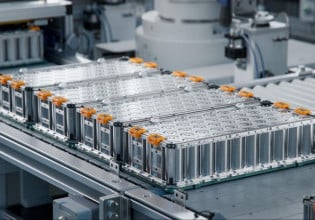Can Lithium Metal Batteries Replace Industry-Standard Li-Ion?
Engineers have made continual improvements to electric vehicle battery technology and design to maximize energy density while preserving safety. Lithium metal batteries have historically been prone to dangerous short-circuiting, but a new artificial solid electrolyte interphase might finally make lithium metal batteries a viable alternative to the standard lithium-ion batteries in use.
The electric vehicle (EV) market is in a state of rapid growth. Despite the incredible advancements in battery technology, the standard lithium-ion battery used in EVs still faces energy density limitations even while it remains a safe option.
Electric vehicle with standard Li-ion battery pack. Image used courtesy of the National Renewable Energy Laboratory
The stability of the lithium-ion (Li-ion) battery has made it a staple of the EV industry, but researchers are still trying to adapt battery system components that would increase range and performance while preserving safety. A team of engineers is developing an artificial solid electrolyte interphase that can reduce the instability that has plagued lithium metal batteries, thus improving their viability.
Li-Ion Battery Advancements and Limitations
Li-ion battery performance has steadily improved over time as components have been refined. From a retrospective vantage point, the Li-ion has proven adaptable, and its volumetric energy density has increased by over eight times in recent years.
Long-term increase in the energy density of lithium-ion batteries. Image used courtesy of the U.S. Department of Energy
Although the Li-ion has improved, it is not guaranteed as the best option for EVs. The graphite-based anodes typically used in Li-ions experience mechanical degradation, which impacts performance. Other tangential issues also affect graphite, such as supply chain complications. China, which produces nearly two-thirds of the global graphite supply, recently instituted a shutdown of graphite exports, citing national security concerns. Experts worldwide fear this could dramatically impact the EV market, especially given that growth has been on a consistent upward trend for years.
The Instability of Lithium Metal Batteries
The lithium metal battery could be a viable alternative to the Li-ion for EVs if problems are addressed. In fact, researchers have been trying to stabilize the lithium metal battery for some time. As far back as 2016, MIT News declared the lithium metal battery the “holy grail” of battery technology because they are almost twice as energy-dense as the standard lithium-ion option.
However, two primary problems exist with lithium metal batteries. First, lithium metal is highly reactive, especially when in contact with the liquid electrolyte component of the battery. Not only does this reactivity reduce the life cycle of the battery, but it also produces the second main problem: dendrite growth. Dendrites form on the anode during charging and are dangerous as they lead to short-circuiting and fires.
As dendrites grow, they can eventually push through the separator and make contact with the cathode. Once this connection is made, electrons can surge through the electrolyte. Lithium metal might offer more energy density, but it has always been less safe than graphite and silicon options because it facilitates dendrite growth.
The Artificial Solid Electrolyte Interphase
When the lithium metal anode comes into contact with the electrolyte, it creates a brittle solid-electrolyte interphase (SEI). The SEI is a liability for battery performance as it reduces lifespan and limits charging capacity.
Researchers at the University of Adelaide, Australia, examined the benefits of an artificial solid electrolyte interphase (ASEI) engineered to avoid the pitfalls of the one that naturally forms. ASEIs can be classified into organic, inorganic, and inorganic-organic composites. The combined inorganic-organic ASEIs are superior because of their toughness, flexibility, and high ionic conductivity, thus harnessing the advantages of both organic and inorganic ASEIs.
Researchers created an artificial SEI. Image used courtesy of SciOpen
The ASEI provides the crucial function of uniformly distributing lithium ions, preventing them from building up on the anode. Preventing this buildup suppresses dendrite growth and mitigates short-circuit risk.
The prospect of stabilizing the historically stubborn lithium metal battery is a prospect that would create a leap in battery power for EVs, making them even more functional and convenient. Another key implication is that this innovation would reduce market dependency on graphite. As engineers continue to advance battery technology by developing new solutions to challenges associated with battery components, the future dominance of the EV market comes closer and closer to the present.









